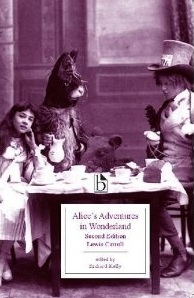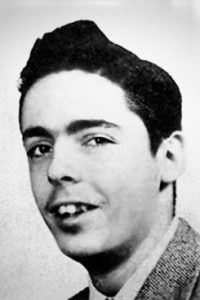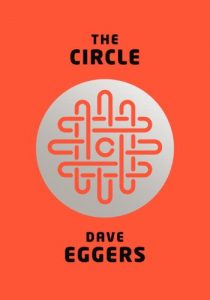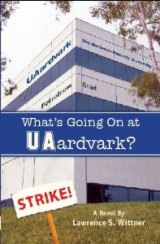Alice’s Adventures in Wonderland
Lewis Carroll
Essay By Dan Geddes
13 March 2001
Chapter I—Down the Rabbit-hole
Chapter III—A Caucus-Race and a Long Table
Chapter IV—The Rabbit Sends in a Little Bill
Chapter V—Advice From a Caterpillar
Chapter VIII—The Queen’s Croquet-Ground
Chapter IX—The Mock Turtle’s Story
Chapter X—The Lobster-Quadrille
Chapter XI—Who Stole The Tarts?
Summary
Alice’s Adventures In Wonderland is effective as a work of fantasy: Alice’s frequent metamorphoses, strange beings such as the pack of cards, the Cheshire Cat, and the Gryphon. A key to the effect is Carroll’s steady tone, which never doubts the events that befalls Alice, and maintains a playful stance toward the absurd utterances and situations with which Alice must deal.
But perhaps even more than the fantastic creatures is the constant wordplay. Few times, I suspect, is anyone whose words could be taken the wrong way not taken the wrong way.
Absurdity is not limited to the characters’ utterances, but also to nature of the situations. The Caucus Race—running in a pointless circle—is the first of many such situations, to be followed by the Mad (and perpetual) tea-party, the Queen’s game of Croquet (using animals for both mallet and ball and guards for the wickets—all moving targets), the trial over the lost tarts (which are never really lost, and the trial over which, in some ways, seems to anticipate Joseph K.’s). Life in wonderland consists of one absurd situation after another, and the Alice’s efforts to understand her situation is only frustrated by language, as the other characters bog her in down in strange language-games, or make her recite verse as proof of her confessed confusion. As such, Alice is also confronts characters whose application of knowledge and language make Alice question the value of education—at least how it is used in wonderland.
Introductory Poems
Chapter I—Down the Rabbit-hole
Alice falls asleep:
Alice sees a white rabbit scampering along, telling itself “I shall be late” and consulting its watch (an obvious time symbol). Alice follows the rabbit down a long hole, passing maps, books, and an empty jar of orange marmalade along the way. During her fall, she calculates how far she has fallen invoking latitude and longitude and the “antipathies” without really understanding them.
The hole ends in a hallway and Alice finds a golden key on a three-legged table. The key opens a tiny door to a lovely garden, but Alice is too large to fit through the door.. She hopes to find “a book of rules for shutting people up like telescopes,” but finds a little bottle saying “DRINK ME”. Alice remembers to check whether the bottle says “Poison” on it, showing her very literal approach to life. It makes her very small, but Alice has forgotten to secure the key, which is still on the glass table.
Alice begins to cry. We are told that “once she remembered trying to box her own ears for having cheated herself in a game of croquet she was playing against herself, for this curious child was very fond of pretending to be two people.” This anticipates the later croquet game, and the Duchess who boxes the Queen’s ears. Also the fact that Alice is fond of pretending to be two people allows us to look at the story’s later numerous dialogues as internal dialogues within the child’s own mind, between facets of her own personality.
Then Alice eats a cake marked EAT ME, expecting to grow very large as a result.
Chapter II—The Pool of Tears
Alice begins growing very large and toys with the idea of sending her own feet a Christmas present. She secures the key, opens the tiny door to the garden, but it is still inaccessible, and so she begins to cry, crying a large pool of tears in the process. She startles the rabbit, who drops his fan and kid-gloves. Alice finds the recent events so strange that she wonders if she is herself, and if she is not, then who is she? This logic leads her to question whether she has become any of her peers. Believing herself too bright to be a dim classmate, she recounts a faulty multiplication table, faulty geographic facts, and an inaccurate version of “How doth the little—“ verse. It is interesting that these facts serve Alice as a test of her identity (“I’ll try if I know all the things I used to know”.) Her poor recitation convinces her she must be the stupid Mabel.
Meanwhile she has unwittingly picked up the rabbit’s gloves and fan, the gloves fitting only because holding the fan has made her small again. She also finds herself nearly drowning in the tears she cried when she was larger. She meets a mouse swimming around, and tries to address it, guessing from a noun declension found in her brother’s Latin book that would be the best way to address the mouse. Instead she tried French: “Ou est ma chatte?” Alice tells the mouse entirely too much about her cat, Dinah. Other animals are now swimming about in the pool of tears and Alice leads them to shore.
Analysis
For the undiscriminating symbol-hunter, there is much fodder in these first two chapters. She sees a rabbit (fertility symbol) bearing a watch (time symbol). In a curious way, Alice’s adventures echo Biblical stories. She falls down a hole. After eating something she is prevented by her large size from entering a garden. This is in term prompts a flood filled with many animals. I’m ashamed to even pursue this line, but it strikes me while reading.
Chapter III—A Caucus-Race and a Long Table
The first order of business for Alice and the animals is to get dry. The Lory claims his authority (because of his seniority) over Alice, but adamantly refuses to give out his age (showing the arbitrariness of authority).
The mouse attempts to dry them off by delivering a boring history lecture (associating the mouse with educators). The Duck questions the Mouse’s use of the construction “the archbishop…found it advisable”, not knowing what “it” refers to in such a phrase. The Dodo is something a political figure, and suggests running a circular caucus-race without winner, rhyme, or reason, as a means to dry them off. Though circular and futile, it is effective.
The Dodo pronounces all of them are winners of the race, and as such merit prizes which Alice must give to them all, including herself (probably satirizing the way in which political systems tax and redistribute wealth, often pointlessly).
Then there are word plays on “tale” and “tail”, “not” and “knot” (with the mouse’s tale/tail relevant in anticipating the later pointless trial by the King and Queen of Hearts. After offending the Mouse again, Alice inadvertently frightens all the birds away by mentioning Dinah, her cat.
Chapter IV—The Rabbit Sends in a Little Bill
The White Rabbit mistakes Alice for “Mary Ann” (presumably his maid), and tells her to run back to his house to fetch another pair of white kid-gloves and a fan. Alice complies, enters the house. She drinks from a little bottle, which soon makes her grow to an enormous size, barely able to fit inside the house at all.
The White Rabbit, makes various attempts to evict the large Alice, most notably by sending a lizard named Bill down the chimney after her—Alice kicking into the sky. Eventually they start throwing pebbles at her, pebbles which turn into little cakes. Alice eats one and finds that it makes her smaller, eventually small enough to leave the White Rabbit’s house by the front door. They all give chase but Alice escapes.
Alice encounters a puppy, humungous compared to Alice’s current height. Alice has to play a game of fetch-the-stick with the dog to tire it out and make her escape.
Alice is now concerned with how to make herself large again.
Chapter V—Advice From a Caterpillar
A caterpillar sitting on large mushroom is smoking a hookah. It questions Alice as to who she is, and Alice tries to explain all the transformations she has undergone that day, but the caterpillar is curt and unsympathetic with Alice’s uncertain explanations. In order to test Alice’s memory, the caterpillar asks her to recite the verse “You are old, Father William.”
After engaging her in more frustrating discussion, the caterpillar leaves Alice, informing her that one side of the mushroom will make her larger and the other smaller. Not knowing how to determine what are the sides of a round mushroom, Alice reaches out to take bits from either side of it.
Alice grows large again, with a rubbery neck, and encounters a Pigeon, who is convinced that Alice is either a serpent, or, that like a serpent, with its wiry neck, it means to eat the Pigeon’s eggs. Alice takes leave of the Pigeon, seeing a little house in the distance.
Chapter VI—Pig and Pepper
Alice sees a liveried footman (with the face of a fish) read a letter to a frog-footman, telling it that the Duchess is invited to play croquet with the Queen. Alice approaches the forg-footman, who tells her it is no use in knocking when they are the same side of the door; he also engages in other conversation underscoring the absurdity of the situation.
Eventually Alice enters to see the Duchess holding a baby, a cook cooking soup with way too much pepper in it, and a grinning Cheshire Cat. The Duchess calls the baby “Pig!”, the cook throws kitchen utensils at the Duchess (who is oblivious to this, even when struck). Alice and the Duchess converse a little bit, the Duchess being very rude, and eventually saying “Cut off her head!” which is the refrain of the Queen of Hearts later in the book. The Duchess hands off the baby to Alice, asking her to nurse it. Alice, fearful for the baby’s life, takes it out of the house. As she walks along carrying it, it eventually transforms into a pig, and Alice puts it down to run freely.
Alice then encounter the Cheshire Cat, which grins constantly. The Cat tells Alice that everyone “here” is mad, including her. The Cat tries to give Alice some general instruction of the terrain, telling her that March Hare lives one way, and the Hatter the other. Then the Cat disappears into a tree, with only its grin visible.
Chapter VII—A Mad Tea-Party
Alice comes upon a tea-party attended by a Hatter, March Hare, and a Dormouse, who is asleep. The tea-party features absurd questions from the March Hare and the hatter, and is itself absurd in that the Hatter claims to have had Time (someone he knows) stop time. Now it is always tea-time, and the three move about constantly to new places, not having time to wash up.
They wake up the Dormouse, demanding he tell them a story. He tells them an absurd story about some people who live in a treacle well. He keeps dropping off during the telling, and the other two try to stuff him into a teapot.
Alice is fed up with them all, and leaves. She finds herself again in the long hall, as in Chapter I.
“A Mad Tea-Party” may be the most entertaining chapter in the book, with delightfully absurd repartee (“Have some wine?” / ”I don’t see any wine” / “There isn’t any.”), an absurd riddle (“Why is a raven like a writing-desk?” / “…What’s the answer?” / “I haven’t the faintest idea?”), the Hatter’s watch that doesn’t tell time (only the month), the circular absurdity of the perpetual tea-party itself (moving down one place only benefiting the hatter), the Dormouse’ preposterous story about the people in the treacle-well, and numerous puns.
Chapter VIII—The Queen’s Croquet-Ground
Alice encounters three playing-cards painting the white leaves of a rose-tree red. The Queen had told them to plant red ones, and they fear that displeasing the Queen puts their lives in jeopardy.
Alice meets the Queen, who is fond only of saying “Off with his head!” But she invites Alice to play croquet. On the Queen’s Croquet-Ground, hedge-hogs serve as balls, and flamingos serve as mallets, and two soldiers stand in an arch to form a wicket—a very vain endeavor indeed.
The Cheshire-Cat appears to Alice and they converse. The King, Queen, and Executioner get bogged down in a debate over whether the Cat’s Head (the only part of the Cat visible to them) can itself be beheaded.
Chapter IX—The Mock Turtle’s Story
Alice encounters the Duchess again, who is found of finding morals in matters whether they suggest themselves or not (“Everything’s got a moral, if only you can find it”). The croquet players take advantage of the queen’s absence by resting themselves. The Queen has the Gryphon take Alice to hear the Mock Turtle’s Story.
The Queen says that Mock Turtles are what mock turtle soup is made from, hence it is drawn with a calf’s head. The Mock Turtle claims to have been a real turtle once. The Mock Turtle does extensive punning, especially about academic subjects.
Chapter X—The Lobster-Quadrille
The Mock Turtle, the Gryphon, and Alice all engage in an absurd dance known as the Lobster-Quadrille. They sing a funny song, and pun about sea creatures (“whiting”, “sole”). Alice relates to them her day’s adventures. To test Alice’s memory they ask her to recite some verse. The Mock Turtle sings a song called “Beautiful Soup.”
Chapter XI—Who Stole The Tarts?
The King and Queen of Hearts are presiding over a trial, concerning some supposedly missing tarts, which are really sitting on a table before them. They have accused the Knave, who is in custody. A jury of 12 creatures is sitting in the jury box, busily writing the most mundane facts and utterances upon slates.
The King is anxious to get on with things, and keeps telling the jury to consider its verdict; but the herald, the White Rabbit, with a better grasp of procedure, repeatedly tells him that more evidence must be considered. The Queen wants to sentence before the verdict.
The Hatter is called as a witness, but has nothing relevant to relate. Consider this passage:
“Take off you hat,” the King said to the Hatter.
“It isn’t mine,” said the Hatter.
“Stolen!” the King exclaimed, turning to the jury, who instantly made a memorandum of the fact.
The King seems a caricature of judicial excess, telling the Hatter “…don’t be nervous, or I’ll have you executed,” and “You must remember or I’ll have you executed.”
Alice, for her part, begins growing large again.
The Duchess’ cook is also called as a witness.
Chapter XII—Alice’s Evidence
Alice is called upon as a witness, upsetting the jury box in the process. The King makes an impromptu rule that persons more than a mile high (obviously directed at Alice) must leave the court. Alice challenges the rule, knowing he just made it up.
A piece of paper is discovered, supposedly a decisive piece of evidence. Despite the fact that it in no way suggest the Knave wrote it, the King and Queen take it as evidence against him (the Knave must feel like Joseph K. from Kafka’s The Trial). The paper contains a poem full of pronouns with ambiguous references. It could be construed to mean anything, but the King and Queen find ways to make it implicate the Knave. Alice contests that any meaning at all can be found in it, and the Queen becomes incensed with her, and orders her head chopped off.
At this Alice throws the pack of cards into the air, and they land on her, and she wakes up, lying in her sister’s lap.
After Alice relates her adventures to her sister, Alice’s sister dreams of Alice’s adventures.
13 March 2001









Be First to Comment